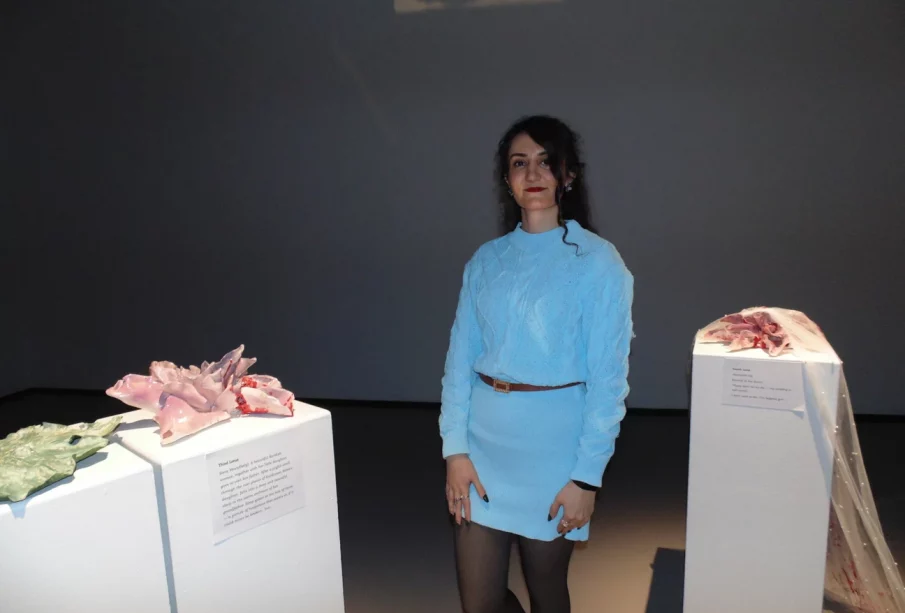Mahtab Ghasemi speaks on violence against women through art
This year, the exhibition Zahhak, say Hi to the End was shown at the Fifth Parallel Gallery. The exhibition was of a collection of ceramic art from the mind and heart of Mahtab Ghasemi, a Master of Fine Arts (MFA) graduate student at the University of Regina (UofR). Her exhibition remembers the women in Iran who faced violence and the lives lost during the 2022 Woman, Life, Freedom movement.
Ghasemi’s life in Iran
In her family, Ghasemi was known to use her voice to stand up for herself and others. “My parents [couldn’t] force me to do what I didn’t want to do,” she shared. “My father realized that I had this power and that I didn’t get scared.”
Ghasemi expressed that she got into a lot of trouble because of the burning fire inside of her. Back in Iran, she often stood up for people in public spaces who were getting hurt or bullied. She knew she had to do something when she noticed indifference from others. “I try to be their voice. It bothered me that I was the only voice for them [when it happens] in the bus or the subway.”
Since childhood, Ghasemi has been fighting for women’s rights. “Mahtab was the first woman that I protected, I brought her over to [Canada] because Iran wasn’t safe for her,” she stressed.
The Woman, Life, Freedom movement came into motion after the death of Mahsa Amini. On Sept. 27, 2022, Amnesty International released a statement calling for accountability after Amini, a 22-year-old woman, died in custody of the “morality” police in Tehran after being detained for violating compulsory veiling laws. Three months before she was set to immigrate to Canada, Ghasemi witnessed the women at the forefront of the uprising and decided to join the protests. “My cousin told me [I] was crazy and shouldn’t go to the streets because I was leaving,” said Ghasemi. “I [told] them they don’t understand. The regime hasn’t fallen yet, but it is happening inside [of] the people.” She saw change happen in the way women were treated. A precious memory for Ghasemi was receiving flowers, notes, and seeing women being called heroes out in the streets.

Zahhak, say Hi to the End
Ghasemi’s exhibition at the Fifth Parallel Gallery was open to the public from Oct. 10 to Oct. 24. There was a long journey towards the completion of her proposal, which had to be revised multiple times before being approved. Ghasemi said the hardship could be attributed to being a perfectionist and because of the complicated topics she had to narrow down. “I made time to come to the studio and think about the final show and find how I can translate what I want into ceramic,”she said. “It should be understandable for my Iranian and non-Iranian audience.”
Her work is centred on women and this is apparent in the message of her exhibition. She drew parallels between Iranian mythology and seven real stories of women. The exhibition’s title was inspired by the tale of Zahhak, a tyrant who fed young people to a snake, which Ghasemi likened to the regime. The lotus flower was used to represent the seven stories because of its symbolism of femininity, resilience, and power.
“The flower is like a woman for me because it’s beautiful and fragile, but still powerful,” explained Ghasemi. “Like a lotus, it’s raised up in dirty and murky water. I translated that to the situation we were raised up in, in Iran.”
In the middle of the exhibition stands the piece titled “Center Lotus,” in which the lotus flower and petals are placed on a mirror while a cloth hangs above it. The flower is arranged similarly to how it is shown on the flag hung at the entrance of the gallery. “I used a mirror to show blurriness and it reflects the flag without the lotus items,” Ghasemi discussed. “The gap between the flag and the lotus is the hope that we have for freedom [from the regime]. It’s incomplete because it’s kind of the unfulfilled hope for us.”
A precious memory for Ghasemi was receiving flowers, notes, and seeing women being called heroes out in the streets.”
Stories of women

Ghasemi created seven lotuses that show that they have been injured, bloodied, or killed. The “First Lotus” represents the story of 16-year old Nika Shahkarami, who went missing after participating in a protest. She died at the hands of Iranian police in Sept 2022.
The “Second Lotus” depicts bloodied lotus petals inside a suitcase. It reflects the story of Maryam, Ghasemi’s cousin, who died at the hands of her ex-husband. Ghasemi wishes to critique the domestic violence that happens under the regime. A suitcase was used because it is often utilized to carry and hide the body of a woman.
The “Third Lotus” shares the story of Sima Moradbeigi who was shot in the arm multiple times in Oct 2022 while taking part in the protests. Ghasemi shared that she has been following Moradbeigi’s story and wishes her well for her continued recovery. These are just a few examples of the stories that the exhibition explored. For Ghasemi, she hopes that her audience’s takeaway would be to stand up for their rights.
She happily reminisced about the big sheets of paper that hung on the walls of the gallery. For the duration of the exhibition, visitors were encouraged to write their comments, and she found herself interacting with many non-Iranian students who left the gallery wanting the same change for Iran. “One of the best comments that I got were [visitors] writing down that [they] hope and believe that Iran will be free,” she proclaimed. Ghasemi shares with the Carillon her gratitude towards her best friends and colleagues. “[To] Forogh Sehat, Dana Hoffos, [and] my professor, Mr. Rasull Jalili, whose encouragement and contributions played crucial roles in the development of this project and paper. I will never forget their support,” she declared. Still residing in Regina, Ghasemi disclosed that she continues to heal from her past wounds. She deals with home sickness through indulging in Iranian cuisine and being around friends who can speak her language.










